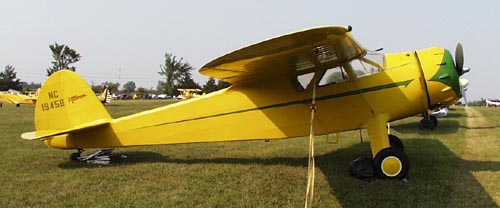The Cessna Airmaster is the plane that rescued the Cessna Aircraft Company from oblivion in the 1930's. Clyde Cessna was a self-taught and well known early barnstormer, racer, and designer of aircraft, and he had gone into business during the 20's building aircraft professionally. Some early examples of his work include the Cessna AW. Clyde Cessna was also involved in the Travel Air company, which is where a number of early aviation pioneers got their start (including Walter Beech and Lloyd Stearman).
Unfortunately during the early years of the Great Depression the Cessna Aircraft Company essentially went out of business, along with most of the rest of the aviation industry. By the mid-thirties the economy was picking up again and Dwane Wallace, a newly minted aeronautical engineer and Clyde Cessna's nephew, decided to build airplanes. He designed the first Airmaster and it first flew in 1934. It was therefore designated a C-34. Further, Wallace persuaded Clyde Cessna to resurrect the remains of the Cessna Aircraft Company and Wallace arranged funding to put the C-34 into production.
The C-34 borrows some design characteristics of the earlier Cessna airplanes, including a high mounted full cantilever wing structure, and a narrow band of cabin windows. Together these give the plane a rather Art-Deco streamlined appearance. Wing construction is all wood, and the fuselage is steel tubing with wooden stringers and formers. The tail surfaces are wooden covered with plywood.

The Airmaster sold reasonably well for the time period, and was sold as the "World's Most Efficient Airplane" after winning several aerial competitions and Trophy Races.
In addition to their reputation for efficiency and speed, Airmasters were used as aerial photography platforms because of their stability in the air. The aircraft that I own was originally a photo plane, having been converted by the Cessna factory to have a camera port in the floor and bottom of the aircraft, downward viewing windows in the lower front fuselage, and a built-in oxygen bottle rack.
The Airmaster models developed from the C-34 into the C-37 and C-38. Improvements included wing-mounted flaps on the C-37 and a belly-mounted drag flap on the C-38, wider fuselages, wider landing gear, and rubber engine mounts. These models were built with the 145 HP Warner Super Scarab engine.
The final iteration of the Airmaster was the C-145 and C-165. On these models the C-38's belly flap was dropped and the wing split flaps put back, and the fuselage was lengthened. The difference between the two models was the engine horsepower, with the C-165 getting an upgraded 165 HP Warner engine.
All of the Airmasters appear to be visually similar. Cues for differentiating the aircraft include the belly drag flap vs. wing flaps, and the location of the bumps on the cowling. C-165s have bumps located further to the rear of the cowling than the Warner 145 hp models. C-34's have narrower landing gear than the later models.
WWII brought an end to the Airmaster line. All together about 180 Airmasters were built. Their classic lines were carried forward by Cessna into the postwar era with the Cessna 195, a much enlarged and all-aluminum cruiser. Even before the 195 was built, though, it too was a throwback design, for by the end of WWII Cessna had hit upon the formula that was to make Cessna the most prolific manufacturer of light airplanes in the world.
The Airmaster's 30's-era technology of welded tubular steel fuselage, fabric covering, extensive fitted woodwork and wooden wing, and somewhat finicky radial engine were all too expensive, slow to produce, and difficult to maintain. Instead the company focused on all-aluminum construction, side-by-side seating, sturdy strut-braced high-wing configuration, monocoque fuselage construction, simple flat spring steel landing gear, and highly reliable horizontally opposed engines. This combination was first seen in the Cessna 120, and it was rapidly developed into the Cessna 140, 170, and ultimately into the utilitarian but incredibly successful 152, 172, and 182.